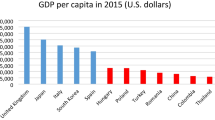Abstract
This paper examines the concept of returns to growth (RTG) of Indian automobile industry by evaluating the relationship between growth of inputs and growth of outputs for estimating the RTG behavior of the major firms. RTG behaviour assumes importance for the Indian automobile industry which operates in a fiercely competitive oligopolistic market environment with clear evidences of price stickiness over last two decades. With increasingly stricter regulatory norms and rising costs of production, the automobile industry faces many challenges to sustain profitability. The firms need to innovate constantly and experience increasing returns to scale (RTS) to remain relevant. The empirical findings of the Indian automobile industry reveal that firms operating under increasing RTS may exhibit constant or decreasing RTG; firms showing constant RTS may exhibit increasing or decreasing RTG; and firms showing decreasing RTS may exhibit constant or increasing RTG. The paper finds that RTS estimates need not provide guidance to the growth strategy behavior of firms which operate under oligopolistic competition which compounds the challenges to remain profitable with a sticky price phenomenon.
Similar content being viewed by others
References
Anderson, R., D. Lewis, and T. Springer. 2000. Operating efficiencies in real estate: a critical review of the literature. Journal of Real Estate Literature. 38 (1): 1–18.
Baumol, W.J., J.C. Panzar, and R.D. Willig. 1982. Contestable markets and the theory of industrial structure. New York: Harcourt Brace Jovanovich.
Cummins, D., and M. Weiss. 2000. Analyzing Firm Performance in Insurance Industry Using Frontier Efficiency and Productivity Methods. In Handbook of Insurance, ed. G. Dionne, 767–829. Boston: Kluwer.
De Borger, B., K. Kerstens, and A. Costa. 2002. Public transit performance: what does one learn from frontier studies? Transport Reviews 22 (1): 1–38.
Harker, P., and S. Zenios. 2001. What Drives Performance of Financial Institutions? In Performance of Financial Institutions: Efficiency, Innovation, Regulation, ed. P. Harker and S. Zenios, 3–31. Cambridge: Cambridge University Press.
Ozcan, Y. 2008. Health care benchmarking and performance evaluation: an assessment using data envelopment analysis (DEA). Berlin: Springer.
Sahoo, B.K., and P.K.J. Mohapatra. 2001. Measuring technical efficiency in data envelopment analysis. Opsearch 38: 456–483.
Sahoo, B.K., and K. Tone. 2009a. Decomposing capacity utilization in data envelopment analysis: an application to banks in India. European Journal of Operational Research 195: 575–594.
Sahoo, B.K., and K. Tone. 2009b. Radial and non-radial decompositions of profit change: with an application to Indian banking. European Journal of Operational Research 196: 1130–1146.
Sahoo, B.K., P.K.J. Mohapatra, and M.L. Trivedi. 1999. A comparative application of data envelopment analysis and frontier translog production function for estimating returns to scale and efficiencies. International Journal of Systems Science 30: 379–394.
Sahoo, B.K., J.K. Sengupta, and A. Mandal. 2007. Productive performance evaluation of the banking sector in India using data envelopment analysis. International Journal of Operations Research 4: 63–79.
Sahoo, B.K., K. Kerstens, and K. Tone. 2012. Tone. Returns to growth in a non-parametric DEA approach. International Transactions in Operational Research. 19: 463–486.
Sahoo, B.K., R. Singh, B. Mishra, and K. Shankaran. 2017. Research productivity in management schools of India during 1968–2015: a directional benefit of doubt model analysis. Omega 66: 118–139.
Seiford, L.M., and J. Zhu. 2002. Modeling undesirable factors in efficiency evaluation. European Journal of Operational Research 142: 16–20.
Sengupta, J.K. 1999. A dynamic efficiency model using data envelopment analysis. International Journal of Production Economics 62: 209–218.
Sengupta, J.K. 2002. Model of hyper competition. International Journal of Systems Science 33: 669–675.
Sengupta, J.K. 2003. New efficiency theory: with applications of data envelopment analysis. Berlin: Springer.
Sengupta, J.K. 2004. Competition and growth: innovations and selection in industry evolution. London: Palgrave Macmillan.
Sengupta, J.K. 2005a. Nonparametric efficiency analysis under uncertainty using data envelopment analysis. International Journal of Production Economics 95: 39–49.
Sengupta, J.K. 2005b. Data envelopment analysis with heterogeneous data: an application. Journal of the Operational Research Society 56: 676–686.
Sengupta, J.K. 2007. Dynamics of entry and market evolution. New York: Palgrave Macmillan.
Sengupta, J.K. 2011. Understanding economic growth: modern theory and experience. New York: Springer.
Sengupta, J.K., and B.K. Sahoo. 2006. Efficiency models in data envelopment analysis: techniques of evaluation of productivity of firms in a growing economy. London: Palgrave Macmillan.
Silva, E., and S.E. Stefanou. 2003. Nonparametric dynamic production analysis and the theory of cost. Journal of Productivity Analysis 19: 5–32.
Silva, E., and S.E. Stefanou. 2007. Nonparametric dynamic efficiency analysis. American Journal of Agricultural Economics 89: 398–419.
Solow, R.M. 1997. Learning from learning by doing: lessons for economic growth. Stanford: Stanford University Press.
Sweezy, P.M. 1939. Demand under conditions of oligopoly. Journal of Political Economy. https://doi.org/10.1086/255420.
Tone, K., and B.K. Sahoo. 2003. Scale, indivisibilities and production function in data envelopment analysis. International Journal of Production Economics 84: 165–192.
Tone, K., and B.K. Sahoo. 2005. Cost efficiency and returns to scale in life insurance corporation of India using data envelopment analysis. Socio-Economic Planning Sciences 39: 261–285.
Worthington, A. 2001. An empirical survey of frontier efficiency measurement techniques in education. Education Economics 9 (3): 245–268.
Author information
Authors and Affiliations
Corresponding author
Additional information
Publisher's Note
Springer Nature remains neutral with regard to jurisdictional claims in published maps and institutional affiliations.
Rights and permissions
About this article
Cite this article
Panigrahi, R. Returns to Growth in Indian Automobile Industry: A Non-Parametric Data Envelopment Analysis (DEA) Approach. J. Quant. Econ. 19, 747–765 (2021). https://doi.org/10.1007/s40953-021-00246-y
Accepted:
Published:
Issue Date:
DOI: https://doi.org/10.1007/s40953-021-00246-y




